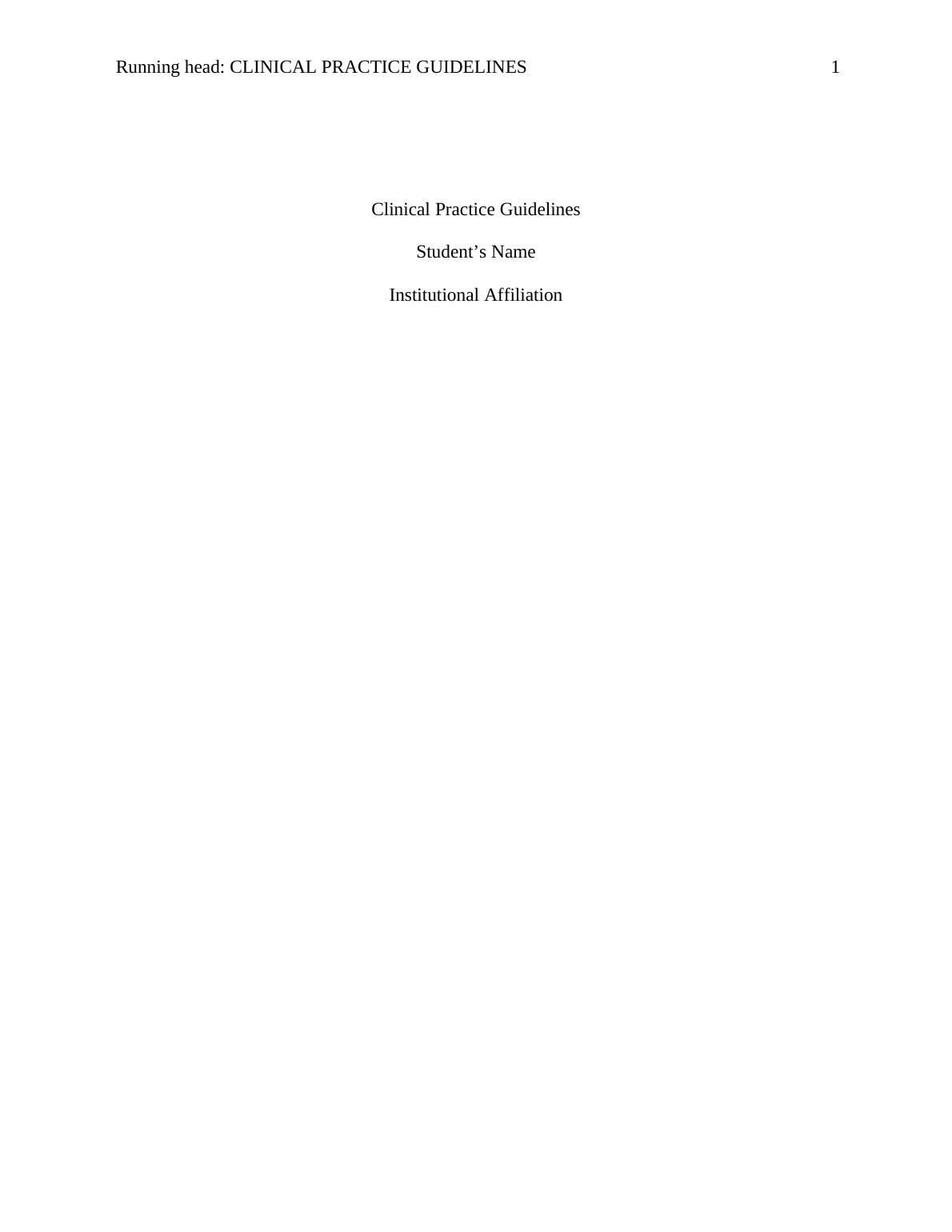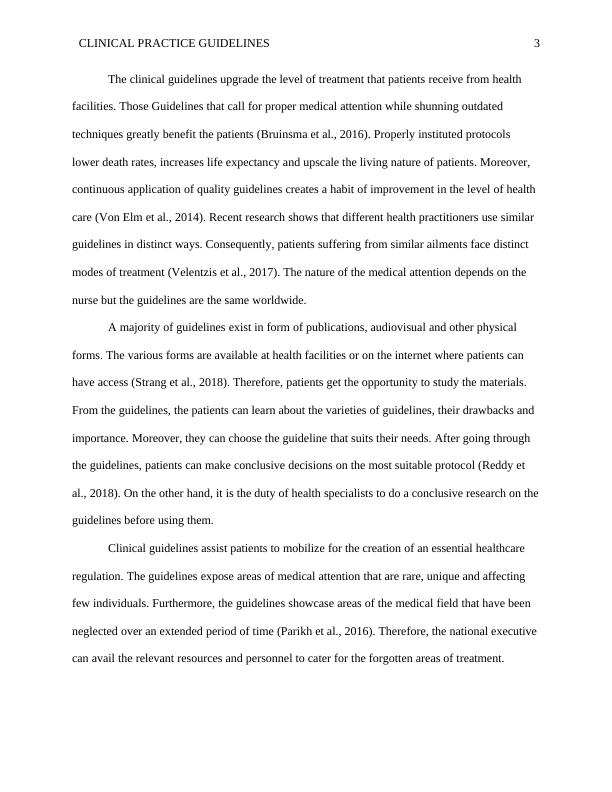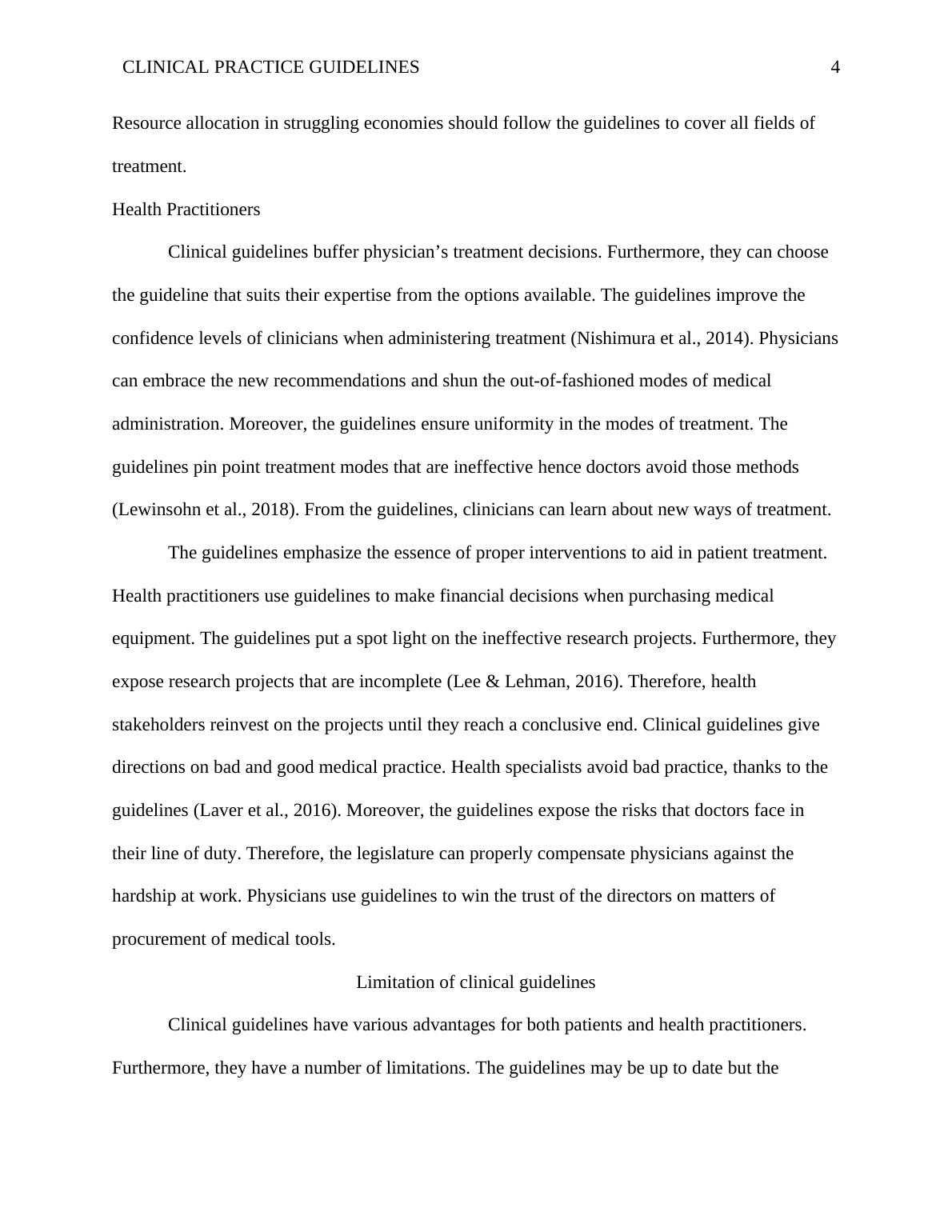Clinical Practice Guidelines: An Overview
Added on 2021-06-15
17 Pages5180 Words464 Views
Running head: CLINICAL PRACTICE GUIDELINES 1Clinical Practice GuidelinesStudent’s NameInstitutional Affiliation

CLINICAL PRACTICE GUIDELINES 2Clinical Practice GuidelinesIntroductionThe use of Clinical Guidelines has spanned over eleven years today (Agha et al., 2016). Most health practitioners are using the protocols to attend to their patients. On a daily basis, treatment of various ailments, management of health facilities, and allocation of funds by the government relies heavily on clinical guidelines. The use of the guidelines started in Europe but is slowing spreading to all other parts of the continents. The main issues that necessitated the onset of clinical guidelines are many. The emergence of strange ailments and expensive technological advancements are some of the main reasons for the development of health care protocols. Additionally, the elevated costs of treatment, inconsistent treatment methods and the increase in the number of patients pushed health practitioners to seek for solutions. The remedy is the development of clinical Guidelines. The development of the guideline involved all stakeholders. This article looks at the definition of the term clinical Guidelines. Furthermore, the paper explains the uses and limitations of the protocols. Additionally, steps in the development of the protocols are in the article. Moreover, the paper looks at the appraisals of key recommendations. Finally, the paper looks at the legal issues on the guidelines and the assessment of the Guardianship protocols.Benefits of Clinical GuidelinesThe essence of clinical guidelines is to upgrade the standards of health care tailor-made by physicians towards patients. A majority of research articles indicate that the guidelines upscale the level of care. However, the interpretation of the importance of the guidelines varies among nurses, patients and other stakeholders.Patients

CLINICAL PRACTICE GUIDELINES 3The clinical guidelines upgrade the level of treatment that patients receive from health facilities. Those Guidelines that call for proper medical attention while shunning outdated techniques greatly benefit the patients (Bruinsma et al., 2016). Properly instituted protocols lower death rates, increases life expectancy and upscale the living nature of patients. Moreover, continuous application of quality guidelines creates a habit of improvement in the level of health care (Von Elm et al., 2014). Recent research shows that different health practitioners use similar guidelines in distinct ways. Consequently, patients suffering from similar ailments face distinct modes of treatment (Velentzis et al., 2017). The nature of the medical attention depends on the nurse but the guidelines are the same worldwide.A majority of guidelines exist in form of publications, audiovisual and other physical forms. The various forms are available at health facilities or on the internet where patients can have access (Strang et al., 2018). Therefore, patients get the opportunity to study the materials. From the guidelines, the patients can learn about the varieties of guidelines, their drawbacks and importance. Moreover, they can choose the guideline that suits their needs. After going through the guidelines, patients can make conclusive decisions on the most suitable protocol (Reddy et al., 2018). On the other hand, it is the duty of health specialists to do a conclusive research on theguidelines before using them. Clinical guidelines assist patients to mobilize for the creation of an essential healthcare regulation. The guidelines expose areas of medical attention that are rare, unique and affecting few individuals. Furthermore, the guidelines showcase areas of the medical field that have been neglected over an extended period of time (Parikh et al., 2016). Therefore, the national executivecan avail the relevant resources and personnel to cater for the forgotten areas of treatment.

CLINICAL PRACTICE GUIDELINES 4Resource allocation in struggling economies should follow the guidelines to cover all fields of treatment.Health PractitionersClinical guidelines buffer physician’s treatment decisions. Furthermore, they can choose the guideline that suits their expertise from the options available. The guidelines improve the confidence levels of clinicians when administering treatment (Nishimura et al., 2014). Physicianscan embrace the new recommendations and shun the out-of-fashioned modes of medical administration. Moreover, the guidelines ensure uniformity in the modes of treatment. The guidelines pin point treatment modes that are ineffective hence doctors avoid those methods (Lewinsohn et al., 2018). From the guidelines, clinicians can learn about new ways of treatment.The guidelines emphasize the essence of proper interventions to aid in patient treatment. Health practitioners use guidelines to make financial decisions when purchasing medical equipment. The guidelines put a spot light on the ineffective research projects. Furthermore, theyexpose research projects that are incomplete (Lee & Lehman, 2016). Therefore, health stakeholders reinvest on the projects until they reach a conclusive end. Clinical guidelines give directions on bad and good medical practice. Health specialists avoid bad practice, thanks to the guidelines (Laver et al., 2016). Moreover, the guidelines expose the risks that doctors face in their line of duty. Therefore, the legislature can properly compensate physicians against the hardship at work. Physicians use guidelines to win the trust of the directors on matters of procurement of medical tools. Limitation of clinical guidelinesClinical guidelines have various advantages for both patients and health practitioners. Furthermore, they have a number of limitations. The guidelines may be up to date but the

End of preview
Want to access all the pages? Upload your documents or become a member.
Related Documents
Roles of Nurses in Treatment Assignment PDFlg...
|16
|4473
|50
Clinical Reasoning Cycle for Healthcare Providers and Nurseslg...
|11
|3275
|160
Quality Management in Healthcarelg...
|24
|8157
|419
Nursing Assignment | Nurse Practitioners and Clinical Nurse Specialistslg...
|13
|3214
|153
Leadership and Practice | Reportlg...
|5
|837
|16
Law and Ethical Issues in Health Carelg...
|15
|4536
|104
